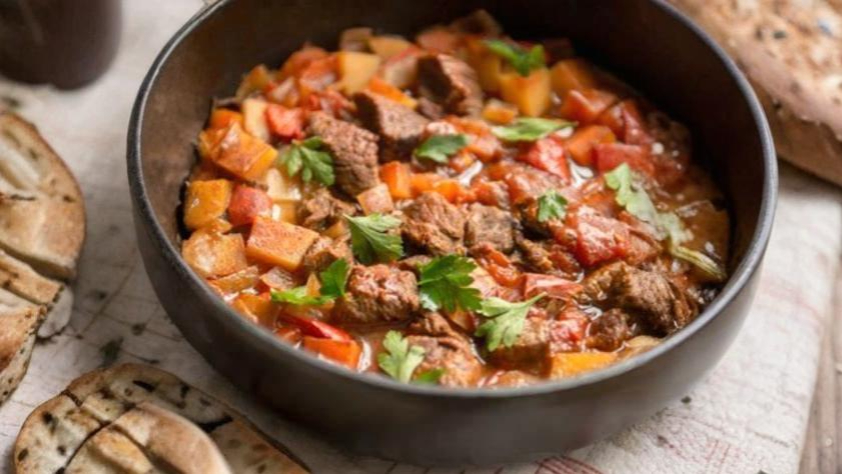Fojatosgarto is a traditional Hungarian dish that combines tender pork belly slices with a rich, paprika-based sauce enriched with sour cream. Originating in the Hungarian countryside during the 19th century, this hearty meal was crafted by farmers using readily available ingredients to create a comforting and flavorful experience.
Key Ingredients Required for Fojatosgarto
To authentically prepare fojatosgarto, specific ingredients are essential to achieve its distinctive flavor profile. The traditional components include:
- Hungarian Sweet Paprika: Approximately three tablespoons of this bright red, aromatic spice provide the signature color and depth of flavor.
- Pork Belly: Two pounds of fresh, skin-on pork belly, sliced into one-inch pieces, serve as the dish’s primary protein, offering richness and tenderness.
- Yellow Onions: Two large onions, finely diced, form the flavor base when caramelized, adding sweetness and complexity.
- Hungarian Sour Cream (Tejföl): One cup of full-fat tejföl contributes creaminess and a slight tang, balancing the robust flavors.
- Fresh Dill: A quarter cup of chopped dill adds a fresh, herbaceous note, enhancing the overall taste.
- Garlic: Four to five fresh cloves, minced, introduce aromatic depth to the dish.
- All-Purpose Flour: A quarter cup is used to create a roux, thickening the sauce to the desired consistency.
- Lard: Two tablespoons of traditional cooking fat impart a rich flavor; however, alternatives like vegetable oil can be used.
- Black Peppercorns: One tablespoon of whole peppercorns adds subtle heat and complexity.
- Hungarian Bay Leaves: Two to three dried leaves infuse the dish with earthy undertones during cooking.
These ingredients harmoniously blend to create the comforting and flavorful essence of fojatosgarto.
Cooking Process and Difficulty Level
While fojatosgarto may appear intricate, its preparation is approachable with attention to detail and patience. The process involves several key steps:
- Browning the Pork Belly: Begin by heating lard in a heavy-bottomed pot over medium heat. Add the sliced pork belly and cook until each piece is evenly browned, ensuring a rich flavor base.
- Caramelizing the Onions: Remove the browned pork and set aside. In the same pot, add diced onions and cook until they become golden and sweet, scraping up any browned bits from the pork.
- Creating the Paprika Roux: Stir in minced garlic and Hungarian sweet paprika to the caramelized onions, cooking briefly to release the spices’ aromas without burning them.
- Deglazing and Simmering: Return the browned pork to the pot, mixing it with the onion-paprika mixture. Pour in enough water or broth to cover the ingredients, add bay leaves and peppercorns, and bring to a gentle simmer. Cover and cook for approximately 90 minutes at 325°F, allowing the flavors to meld and the pork to become tender.
- Incorporating Sour Cream: Temper the sour cream by mixing it with a small amount of the hot cooking liquid to prevent curdling. Stir this mixture back into the pot, creating a creamy and cohesive sauce.
- Final Seasoning and Garnish: Adjust seasoning with salt and pepper as needed. Sprinkle fresh dill over the dish before serving to add a burst of freshness.
The primary challenge lies in managing the slow cooking process and ensuring the proper integration of ingredients to achieve the desired texture and flavor.
Tips for Successfully Making Fojatosgarto
To enhance your fojatosgarto cooking experience, consider the following tips:
- Prepare in Stages: Break down the process by prepping ingredients separately, such as slicing pork, dicing onions, and measuring spices, to maintain organization and reduce stress.
- Don’t Rush the Browning: Take time to properly brown the pork belly, as this step develops a deep, savory flavor that forms the dish’s foundation.
- Use Fresh Ingredients: Opt for fresh herbs and high-quality meats to elevate the dish’s overall taste and authenticity.
- Adjust to Taste: Fojatosgarto is versatile; feel free to modify seasoning levels, such as adding more paprika or garlic, to suit personal preferences.
- Allow for Resting Time: After cooking, let the dish sit for a few minutes before serving to allow flavors to meld and enhance the overall taste.
These insights can help both novice and experienced cooks achieve a satisfying and delicious fojatosgarto.
Best Practices for Beginners
For those new to preparing fojatosgarto, adhering to best practices can ensure a successful outcome:
- Organization and Preparation: Gather and measure all ingredients before starting to streamline the cooking process and minimize errors.
- Temperature Control: Maintain consistent heat levels, especially during browning and simmering stages, to prevent burning and ensure even cooking.
- Technique Essentials: Focus on fundamental techniques, such as proper browning and gentle simmering, to build confidence and achieve the desired results.
- Common Adjustments: Be prepared to make minor adjustments, like adding more liquid if the sauce thickens too much, to maintain the dish’s integrity.
- Safety Considerations: Use appropriate kitchen tools and practice safe handling of hot ingredients to prevent accidents.
Embracing these practices can make cooking fojatosgarto an enjoyable and rewarding culinary endeavor.
